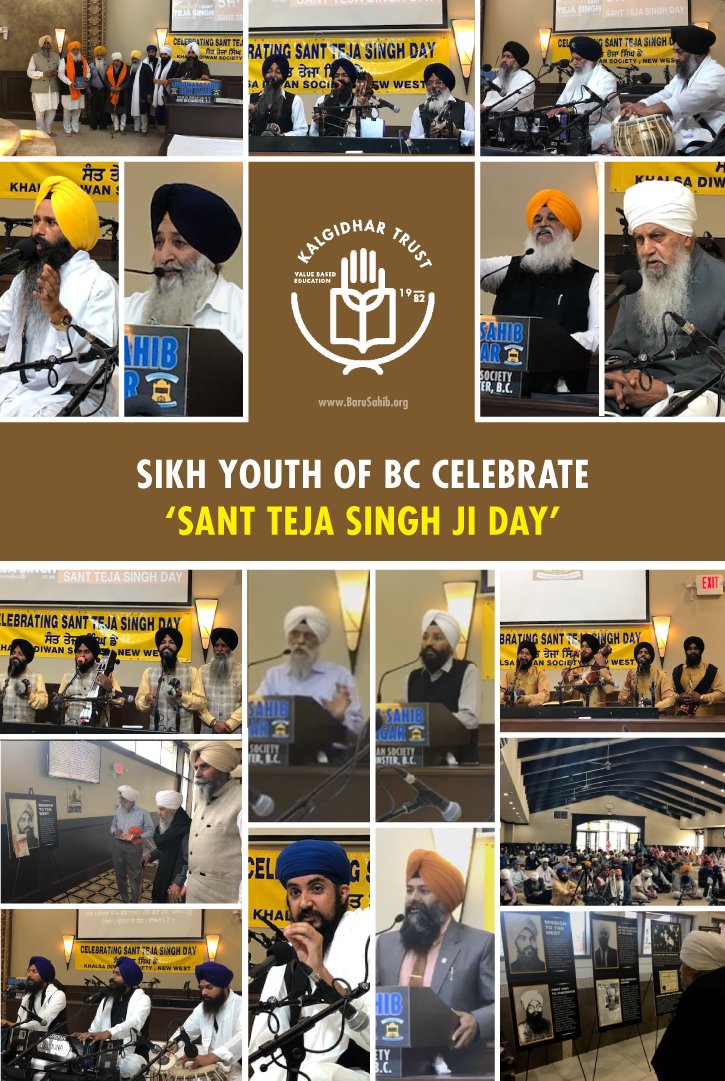To Pay tribute to a true Sikh Sevadaar, the Sikh Youth of BC Celebrate Sant Teja Singh Day (Canada Day) each year on July 1st at Khalsa Diwan Society, Gurdwara Sukh Sagar, New Westminster. This year’s program will begin on Friday, June 29 with an Akhand Path Aramb at 9.00am and conclude with Bhog Akhand Path, Kirtan/Katha and Speakers and Presentation on July 1.
The great Sant Teja Singh was a true Sikh Sevadaar and the first Ambassador of Sikhism to the western Hemisphere. He was also the founder of first Sikh Gurdwara’s in Canada, USA and UK was a charismatic personality.
His seven years sojourn in the West spanned from 1906-1913. Historians’ account of his contribution is sketchy and skewed. In his twenties, his academic achievements were stupendous. A man of his ability, intelligence, and erudition at a tender age could have risen to legendary eminence during his time. Very few would get opportunities that he had at the start of his career as administrative head, civil servant, and the educational leader of one of the best institutions of his time.
Similarly, he had many prospects to excel in the West. But he was a class apart. He had no ambition for his personal success after he was touched profoundly by a seer who had considerable following in Punjab.
His submission to his spiritual guide was complete and unselfish. His master gave him a mission that ranged from organizing the community to – enshrining freedom, peace and spiritual poise in their lives. He transferred community wisdom to them that gave them a rare courage to face unique challenges in their social and political life. Sant Teja Singh’s name is associated with First Sikh Gurdwaras in England, Canada and United States of America.
Sant Attar Singh, a renowned saint of Mastuana, sent him to the western world with a message that there was nothing in occult and ridhi sidhis. Swamis from India were swarming the whole western world at that time with claims to supernatural powers by psychical and magical means. They were urging westerners to get absolute lordship of world by acquisition of mystic power to subjugate others through ancient mantras.
Sant Teja Singh gave a different message to the world that nothing was higher than the hard work, honest living and devotion to the creator. It is very important to know the multidimensional life of such a unique personality
Life of Sant Teja Singh Ji is a model of transformation of a highly educated, immaculate rationalist into a pious spiritually enlightened ideal man – a Perfect Gur Sikh (God-conscious person, Gurmukh)’. He was blessed with this remarkable change by following the path of Prema Bhagti (losing oneself in the Eternal Divine by meditation on His Name) of Guru Nanak Dev Ji under the spiritual guidance of Sant Attar Singh Ji, Gur Sagar Sahib Mustuana in District Sangrur of Punjab, India. His life would continue to serve as beacon of light to all those interested in uplift and service of humanity without any distinction of caste, creed, race or color.
Sant Teja Singh, whose given name was Niranjan Singh, was born to mother Sada Kaur and father medical Doctor Ralla Singh at Bolowali in Gujranwala District, Panjab, India on May 14, 1877. The village is located in the vicinity of Eminabad (Saidpur Pathana), where Guru Nanak Dev Ji blessed a carpenter Bhai Lalo,; shook pride of the headman of the area Malik Bhago, and guided him to give up oppressing the poor so that the Divine Name finds a place in thy heart.; and where the Guru, seeing the world ablaze in the fire of jealousy, greed, and selfishness performed austerities determined to pray for them and try some how to find a cure for their ills.
Light shall again come from the east
During his visit to Chicago, Sant Teja Singh met Rev. Jenkins Lloyd Jones, Lord Bishop of the largest Unitarian Church of Chicago, who was a pious learned and highly respected person. After a brief introduction, Sant Teja Singh Ji and Rev. Jones exchanged views on various aspects of spiritualism. Sant Ji explained the sacred mission of Guru Nanak dev Ji for attaining the world peace. At this point, Rev. Jones got up from his chair, warmly shook hands with Sant Ji and with love exclaimed, “Brother Teja Singh, Light shall again come from the East. We in the West are quite unfit for it.” He also invited Sant Ji to participate in the Congress of free Christianity and Religious Progress at Berlin in August, 1910.
Propagation of Sikh Tenets in the West
Opened the Sikh Dharamsala London, UK, Europe 1910
Opened Sikh Temple at Stockton, California 1912
Built Sikh Gurdwara Victoria B.C. Canada 1912-13
Organized Societies to manage these Gurdwaras
Amrit Sanchar in B C Canada and Pacific Coast USA; first Amrit Sanchar and first Sikh marriage according to Sikh Maryada were performed at Vancouver
First Sikh Procession was taken out in Victoria B C at the time of opening the Gurdwara Sahib. Sant Teja Singh delivered lectures on the Sikh Faith throughout the route of the procession. At the end there were as many white people in the procession as Sikhs and other Indian communities.
To Pay tribute to him Sikh Youth of BC Celebrate Sant Teja Singh Day (Canada Day) each year on July 1st at Khalsa Diwan Society, Gurdwara Sukh Sagar, New Westminster.
This year’s program is as following:
Friday, June 29, 2018
Akhand Path Aramb: 9.00am
Katha Darbar : Friday : 6.30 8.30 pm
Saturday, June 30,2018
Dhadi Darbar : 6.30- 8.30 pm
Sunday July 1st,2018
Bhog Akhand Path : 9.00 am
Kirtan/Katha : 9.30-11.00 am
Speakers & Presentation: 11.00am to 1.00pm
Historical Exhibition will be displayed all three days at Gurdwara sahib Lobby .
For More Info: 604-780-7200








